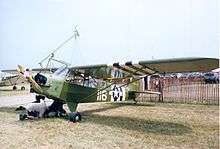Brodie landing system
The Brodie landing system was a method of landing light aeroplane devised by James H Brodie, a Captain of the United States Army Air Forces during World War II. The method of landing involved catching a hook attached to the plane with a sling which itself was attached to a cable. This system proved useful in landing aircraft in normally unsuitable terrain, such as the jungle or in mountains, and also afforded good camouflage.

After tests on land the system was first tested in September 1943 for shipboard use with an installation on the motor ship City of Dalhart. Staff Sergeant R. A. Gregory made ten good takeoffs and hookups with a Stinson L-5 light plane.[1]
Similar non-conventional landing apparatus were previously deployed in limited numbers for airborne aircraft recovery on the 1930s US Navy dirigibles to retrieve small fighters. The Brodie system differed in that the system was based on a wire capture with a larger (longer) target to hit by the pilot. Even though it could be mounted to moving objects, it was also suitable for fixed installations in the jungle.
Brodie was issued US Patent # 2, 435,197, # 2,488,050, # 2,488,051, # 3,163,380 for variations of the landing system.[2]
The system was also used for landing light aircraft on ships, allowing existing ships to be converted to light aircraft carriers with little structural changes. Brodie and test pilot Flight Officer Raymond Gregory were awarded the Legion of Merit for their work on the system in 1945. Brodie envisioned scaling the system up to capture planes as heavy as 7000 lbs.[3]
Operational history
- The LST 776, LST 393 & LST 325 were outfitted with a Brodie landing system.
- The RAF used an L-5 for testing the Brodie system in India.[4]
- One type of light aircraft which used the system was the Stinson L-5 Sentinel, an example of which is displayed in Brodie configuration in the Steven F. Udvar-Hazy Center museum in Dulles, Virginia.
References
- "Bax Seat: Hanging Out With the Brodies". Flying Magazine. Los Angeles: CBS Magazines. 112 (12): 96. December 1985.
- "Brodie Landing System". Retrieved 7 October 2010.
- "Nylon Airport". Popular Mechanics. February 1946.
- http://www.tartanpixel.com/raf/ww2photo.asp
Bibliography
External links
- "L-5 Used in Pacific With Brodie System YouTube
- Brodie System in use for both takeoff and recovery with Piper L-4 and Stinson L-5 aircraft YouTube